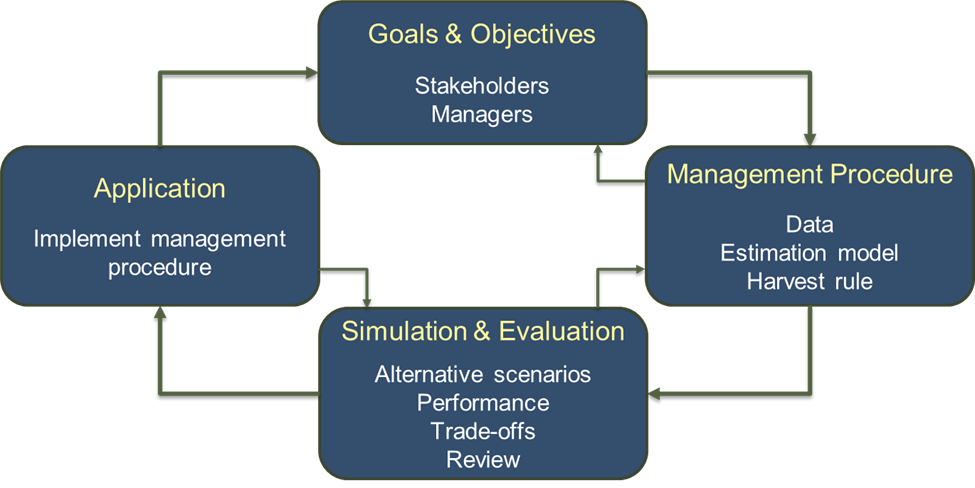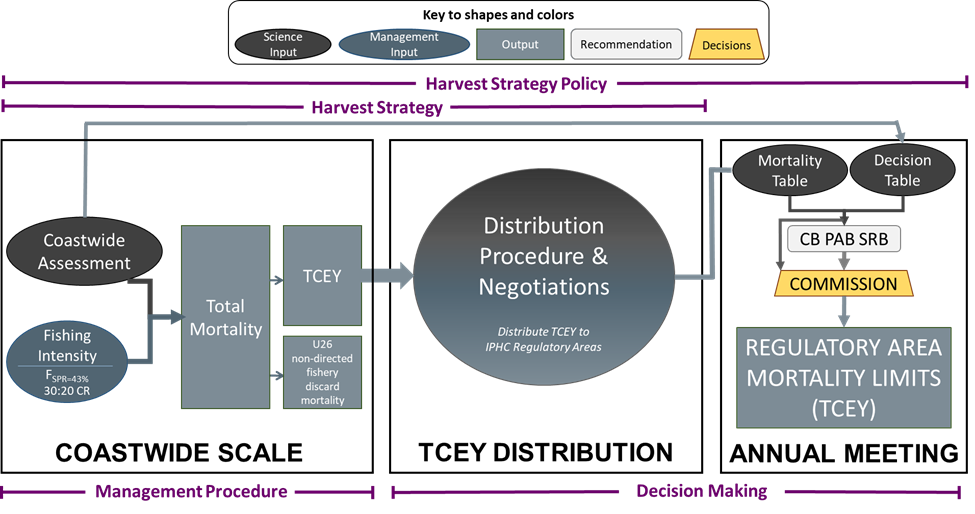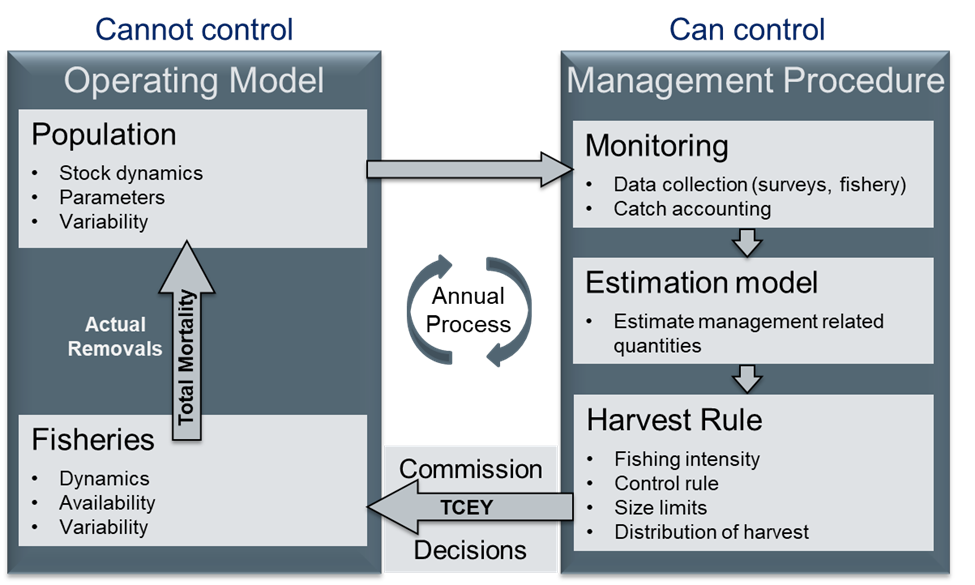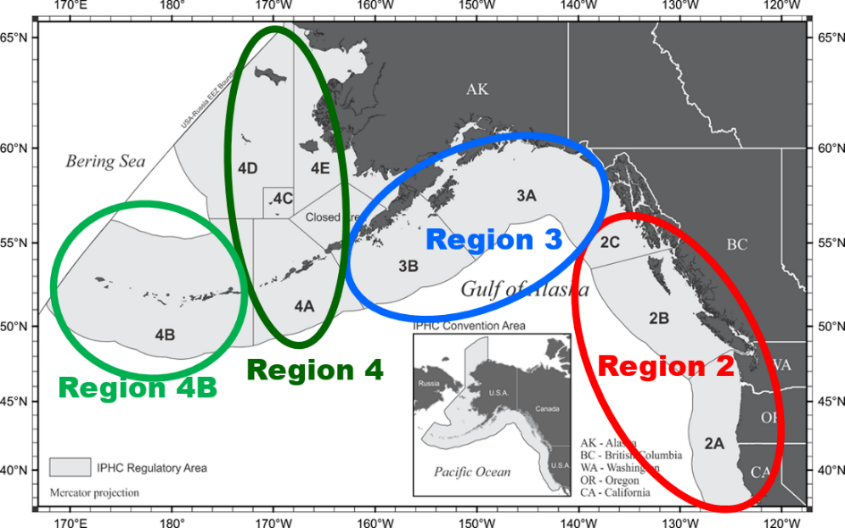At its 89th Annual Meeting in 2013, the Commission endorsed the development of a program of Management Strategy Evaluation (MSE) for the Pacific halibut (Hippoglossus stenolepis) resource occurring within the Convention Area. In doing so, the Commission approved the formation of a Management Strategy Advisory Board (MSAB), tasked with advising the IPHC Secretariat on the Management Strategy Evaluation (MSE) process.
What is Management Strategy Evaluation?
Management Strategy Evaluation (MSE) is a process to evaluate the consequences of alternative management options, known as management procedures or harvest strategies. MSE uses a simulation tool to determine how alternative management procedures perform given a set of pre-defined fishery and conservation objectives, taking into account the uncertainties in the system and how likely candidate management procedures are to achieve the chosen management objectives.
MSE is a simulation technique based on modelling each part of a management cycle. The MSE uses an operating model to simulate the entire population and all fisheries, with potential ecosystem effects. The monitoring program, the estimation model, and management decisions (i.e. the management procedure) are factored in using closed-loop simulation. Additional elements of the harvest strategy that are not specifically defined with a procedure are simulated with uncertainty and may not have objectives associated with them. For example, allocation is often a negotiated part of the decision-making process, is not predictable, and is not subject to specific evaluation.
Undertaking an MSE has the advantage of being able to reveal the trade-offs among a range of possible management procedures. Specifically, to provide information on which to base a rational decision, given objectives, preferences, and attitudes to risk. The MSE is an essential part of the process of developing and agreeing to a harvest strategy policy.
The MSE process involves:
- Defining fishery and conservation objectives with the involvement of stakeholders and managers;
- Identifying management procedures (a component of harvest strategies) to evaluate;
- Simulating a Pacific halibut population using those management procedures;
- Evaluating and presenting the results in a way that examines trade-offs between objectives;
- Implementing a chosen harvest strategy with the tested management procedure;
- Repeating this process in the future in case of changes in objectives, assumptions, or expectations.

Figure 1. The general process of management strategy evaluation.
Undertaking an MSE requires scientists, managers, and stakeholders to be involved throughout the process. While the scientists do the modelling, managers must offer extensive input. Because of the many steps and the iterative process, communication among parties is critical for achieving buy-in on the results of the management strategy evaluation.
Current MSE documents:
Document
Title
Availability
IPHC-2024-MSE-01
IPHC Management Strategy Evaluation and Harvest Strategy Policy Updates for 2023
19 Jan 2024
External peer review
At the 95th Session of the IPHC Annual Meeting (AM095) in January 2019, the Commission agreed to implement an additional process of external peer review of the IPHC Management Strategy Evaluation process over the course of 2019/20. The following is a list of key documents relating to the 2020 independent peer review:
Harvest Strategy Policy
The current interim harvest policy in the IPHC harvest strategy policy contains two distinct components (Figure 2). The first is related to coastwide scale and determines the overall coastwide mortality on the Pacific halibut stock. This has a formulaic approach and associated objectives, thus is a management procedure. The second is the distribution of coastwide mortality (TCEY) to the IPHC Regulatory Areas, which does not have a specific approach, is subject to decision-making uncertainty, and does not currently have associated area-specific objectives. Domestic catch sharing plans and other agreements determine how the TCEY is allocated among the fishery sectors within an IPHC Regulatory Area. The framework for the harvest strategy policy is described in the harvest strategy policy document.

Figure 2. An illustration of the current interim IPHC harvest strategy policy process showing the coastwide scale and TCEY distribution components that comprise the harvest strategy. The decision-making process considers inputs from many sources.
MSE Framework
The MSE framework is the implementation of the MSE process including the interplay between the main elements of an MSE (i.e., objectives, management procedures, simulation, evaluation, and application as seen in Figure 1) as well as the components within each of those main elements. A major part of the framework is linking a management procedure to the operating model with a closed-loop feedback (Figure 3).
The operating model simulates the Pacific halibut population and the fishery, consisting of processes that are not controlled through management. The population and fishery dynamics are specified with mathematical models with variability and uncertainty included as major considerations. Different hypotheses about how the dynamics operate are commonly included in the simulations, which may result in multiple operating models that are specified differently from each other. Operating models are conditioned to data to ensure that they are the best possible depiction of the Pacific halibut population.
The management procedure consists of three elements (Figure 3). Monitoring (data generation) represents the collection of data from the fisheries and population (i.e., operating model) that are used by the estimation model and harvest rule to determine management outputs. Data are simulated in the framework to represent the data collection and sampling process, which may include variability and bias. These data are used by the estimation model to estimate management related quantities to use in the harvest rule. The estimation model may be as simple as using observations of past catches, may be more complex by using the outputs of a fishery-independent survey, or may be as complex as the current ensemble stock assessment which integrates data from multiple sources. The estimation model is subject to estimation error, meaning that it is an uncertain estimate of the management quantities. The harvest rule is the application of the estimation model output in a procedure (Figure 2) that results in mortality limits for Pacific halibut in each IPHC Regulatory Area. The management procedure consists of predetermined steps with a predictable outcome that can be modelled in a computer simulation and is applied consistently year after year.

Figure 3. The closed-loop feedback between the operating model and a management procedure.
A generalized framework has been developed by the IPHC Secretariat for current analyses of management procedures related to scale and distribution components of the harvest strategy and will be useful for future analyses as determined by the Commission. Technical details of the MSE framework are provided in the MSE Technical document.
Operating Model
A multi-area operating model has been developed by the IPHC Secretariat and includes key components relative to Pacific halibut ecology, specifically movement, as well as fisheries within each IPHC Regulatory Area. The modelling of Pacific halibut biology and population dynamics occurs by biological regions (Figure 4). Pacific halibut within the same biological region share common biological traits, and tagging studies have shown that Pacific halibut tend to remain within the same biological region during the year, while movement across regions occurs from one year to the next. Movement between regions is modelled by means of age-specific transition matrices. The operating model is implemented in the C++ programming language, and despite being developed specifically for Pacific halibut, it is flexible enough for use with different species.

Figure 4. Biological Regions overlaid on IPHC Regulatory Areas with Region 2 comprised of 2A, 2B, and 2C, Region 3 comprised of 3A and 3B, Region 4 comprised of 4A and 4CDE, and Region 4B comprised solely of 4B.
Goals and Objectives
One of the key steps in the MSE process is the definition of management objectives related to stock conservation and fishery outcomes. Each objective is quantitatively represented using a performance metric, which is the statistic considered when evaluating the performance of different management procedures. Objectives are defined through the interaction with stakeholders through the MSAB.
The Commission, with the support of the MSAB and IPHC Secretariat, has defined four priority objectives:
- Biological sustainability: Maintain the long-term coastwide female spawning stock biomass above a biomass limit reference point (B20%) at least 95% of the time.
- Optimize fishing activities: Maintain the long-term coastwide female spawning stock biomass above a biomass reference point (B36%) at least 50% of the time.
- Provide directed fishing yield: Optimise average coastwide TCEY.
- Limit catch variability: Limit annual changes in the coastwide TCEY.
Management Procedures and Harvest Strategies
Management procedures (MPs) are the combination of data collection programs, data analysis, and elements of a harvest control rule that specify the formulaic procedure for determining management actions. The MSE process is aimed at evaluating the performance of different management procedures against specific objectives. The management procedure at IPHC is composed of the scale component that defines the coastwide total mortality and TCEY. Priority objectives are currently only defined at the coastwide scale. The harvest strategy also includes the distribution component that defines the distribution of the TCEY to IPHC Regulatory Areas, which may be formulaic to determine a reference distribution, but is adjusted during the decision-making process. The Commission has not defined priority objectives related to distribution of the TCEY or a procedure defining how this allocation occurs. The key differences between an MP and a harvest strategy are the level of specificity and how rigorously each is evaluated against objectives.
The harvest strategy policy is currently in development at IPHC. More information can be found under Harvest Strategy Policy.
To access the linked apps and prevent receiving a security certificate error in your browser, please download and install the IPHC’s security certificate into your browser.
Related: Harvest Strategy Policy
Current results of the MSE can be viewed with the MSE Explorer. Past MSE results presented via other MSE Explorers are available on the IPHC apps website.
